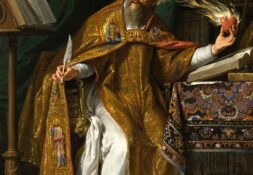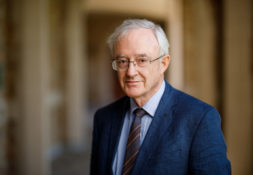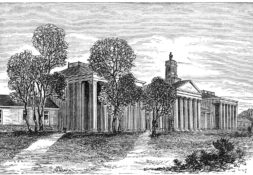In Mozart’s The Magic Flute, an opera we study in my music class, there is a funny and yet quite moving scene. The comic character, Papageno, uses the magic power of his bells to save the heroine, Princess Pamina, from the clutches of Monostatos and his slaves – caricatures of contemporary Turks. As they hear the music, they start dancing and singing like happy kids and all ends well. Pamina and Papageno then sing a joyful duet about the power of harmony: “without this sympathy,” they conclude, “there is no happiness on earth!” This opera is one of those pieces that has an almost universal appeal, very much like Beethoven’s Ninth symphony.
As I type these reflections, the American Musicological Society is having a debate on its e-mailing list about whether the “Turkish March” in the final movement of Beethoven’s last symphony is really Turkish. What is at stake, really, is whether Beethoven is telling us that we must symphonize on the largest scale: bring harmony among people of different faiths and cultures. If that is the case he is simply expressing Schiller’s central idea in the text of his famous Ode: thanks to Joy (meaning ‘harmony’ in every sense of the term) “all men become brothers.” But, to paraphrase Schiller again, embracing the millions, even including Muslims, has always made some people uncomfortable, both in Europe and in America. Yet, Beethoven is telling the truth, whether we like it or not: as long as there is ‘dissonance’ among people of the world there will be no harmony, therefore no universal joy.
Can Catholic liturgical music bring harmony outside the liturgy and outside the Catholic faith? If we teach it as part of our canonic musical culture, is it inclusive or divisive? Beethoven seems to have posed a similar question by including in the first performance of his Ninth symphony some movements from his Catholic Solemn Mass.
Whether Catholic liturgical music has a universal value is a dilemma that I face when I teach liturgical pieces not as pure aesthetical artifacts but as integral parts of the liturgy.I present them this way in order to preserve their original purpose and meaning. Some students and colleagues have expressed their concerns about this on different occasions. If I bring it to the attention of the readers of this paper, I do so because it is a dilemma that we all face when we try, on the one hand, to be as inclusive as possible, as we should be in a university; and on the other hand, when we also attempt to give serious meaning to the mission of this university. If as a teacher I ask students to study Gregorian chant, the liturgy of the Mass, the liturgical calendar, the Office of the Hours, text and settings of the Catholic Nicene Creed (even if it is by a Lutheran composer like J. S. Bach), would non-Catholic students feel excluded? Will our students, Catholic and non-Catholic alike, be able to use this knowledge in the world outside our university without feeling or being treated as though they’ve had a sectarian education?
The problem has to do with how we understand the mission statement of the University of Notre Dame. Let’s reread it (http://www.nd.edu/aboutnd/mission-statement/). In the opening, there is no mention of the ‘Catholic’ identity of the university. It says, though, that “the aim is to create a sense of human solidarity and concern for the common good that will bear fruit as learning becomes service to justice.” Schiller could have written that. The Catholic way of carrying out this mission is introduced later, in a separate paragraph entitled “Context.” To paraphrase, the context in which we can build harmony, joy, and solidarity among all men and women on earth is Catholic. So, once again, is Catholic liturgy –not general principles like ‘love’ and ‘peace,’ but a form of worship that is generally perceived as a very distinctive aspect of this faith – of any value for humankind in general?
There is a simple exercise I ask my students to do: go to Mass as an objective observer, and try to understand St. Augustine’s formulation of the nature of time. For Augustine, time exists as a sort of psychological phenomenon. In The Confessions he writes that “the mind expects, attends, and remembers.” This is groundbreaking. Augustine was not trying to be original; he simply discovered this in Milan, where he experienced Catholic Ambrosian liturgy on a regular basis. The time of liturgy is subjective (psychological) but also shared with other human beings. If we think that the time of the liturgy is the time marked by our watches, which we may be tempted to monitor out of boredom, we miss the point: time is shaped fluidly, time is sculpted, stretched, accelerated; at times it seems to freeze and then it moves on again. Augustine was well aware that music plays a fundamental role in this process. It is probably not by accident that opera was first developed in a Catholic country by musicians who were active also as church musicians, that the earliest symphonies were performed in the Church as part of the liturgy. It would be hard to understand these art forms without understanding a culture that for centuries regularly experienced the art of shaping time primarily through liturgy.
Liturgical music also served to shape time at a higher level: before most people had watches, it regulated the hours of the day; liturgical music regulates the days of the week, so that people do not feel that every day is the same; it regulates the passing of the seasons in a way that invites us to remember, to attend, to expect in a rhythmic pattern, a rhythm that is nonetheless asymmetrical enough to make us feel that not every moment or month is the same. Liturgy and its music have given to people around the world a singular taste for time sculptures, which is the essence of many great musical pieces, so that we do not feel trapped in the mechanical, inexorable ticking of a clock. It has also trained people to harmonize subjective experiences and communal experiences, the self and the other. If only for these two reasons – and there are more – Catholic liturgical music has value that can be shared by anybody who is able to immerse him or herself in symphonic music, opera, or movies without monitoring the clock out of boredom.
Pierpaolo Polzonetti is a musicologist who teaches in the Program of Liberal Stu





